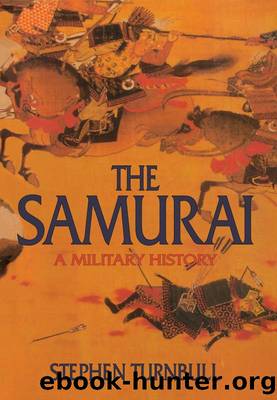The Samurai by Turnbull Stephen;

Author:Turnbull, Stephen;
Language: eng
Format: epub
ISBN: 1223016
Publisher: Taylor & Francis Group
whom faced considerable danger. Ieyasu is recorded as having made good practice with an arquebus, indicating that he was in the thick of things.
Later in the year Nobunaga returned to Åmi to attack Asai, which resulted in the furious Battle of the Anegawa. Nobunaga proceeded from his headquarters of Gifu, in Mino, along the NakasendÅ Road and up the eastern side of Lake Biwa towards Nagahama. On 21 July he neared Odani, Asai's headquarters, which he threatened by attacking Yokoyama Castle about five miles to the south-east Here Ieyasu joined him with 5,000 men of the Tokugawa force from his home province of Mikawa. At this battle we meet for the first time Ieyasu's âShi-tennÅâ, his four chief retainers. Their names were Sakai Tadatsugu, Ishikawa Kazumasa, Sakakibara Yasumasa and Honda Tadakatsu. The last named was a particularly flamboyant character who wore a helmet ornamented with wooden anders. He proved himself as a long established and staunch supporter of the Tokugawa house.
The main forces of Asai, augmented by those of Asakura, took up, positions straddling the road to Otani, with the river Anegawa in between them and Nobunaga's troops. Their plan was to attack at dawn the following day with Asai's 8,000 and Asakura's 10,000. Nobunaga's army outnumbered them by about two to one, and Nobunaga hoped to capitalize upon this numerical superiority by attacking first. In fact his troops were not all reliable, but the questionable contingents had been placed under the watchful eye of Hideyoshi, so Nobunaga had little to fear. He originally intended to let Ieyasu confront Asai, but changed his mind in view of his own relationship, and drew up his personal command of 23,000 opposite his brother-in-law. They were arranged thirteen ranks deep to withstand the shock of a charge.
At 4 am both armies waded into the wide, shallow waters of the Anegawa. Ieyasu's troops, with Sakai and Ishikawa in front, and Honda and Sakakibara in the second rank, met and held Asakura's force in mid-stream. As the battle raged clouds of black smoke drifted across the river from the arquebuses, and the combatants became soaked with sweat, as wefl as wetted by the waters of the red-tinted river. Nobunaga's force was not doing so well. Asai had broken through his ranks and was menacing Nobunaga himself. So Sakakibara and Honda detached their divisions from the struggle on the left wing, crossed the river and descended on to Asai's right flank, while Inaba Ittetsu, whom Ieyasu had held in reserve until that moment, supported Nobunaga's left. The battle was joined by the besiegers of Yokoyama Castle, who left their posts and hastily came to the fight. The result was a victory for Nobunaga. The Northern commanders retired, and half their army lay dead. As a token of appreciation Nobunaga presented Ieyasu with a fine sword, and an arrowhead that once belonged to the âgiantâ Minamoto Tametomo. An incident that occurred during the Anegawa campaign is also worth relating. A samurai called Sasai Masayasu entered Asai Nagamasa's headquarters, spear in hand.
Download
This site does not store any files on its server. We only index and link to content provided by other sites. Please contact the content providers to delete copyright contents if any and email us, we'll remove relevant links or contents immediately.
| Africa | Americas |
| Arctic & Antarctica | Asia |
| Australia & Oceania | Europe |
| Middle East | Russia |
| United States | World |
| Ancient Civilizations | Military |
| Historical Study & Educational Resources |
The Story of China by Michael Wood(907)
Mr. Selden's Map of China by Timothy Brook(756)
Heroic Hindu Resistance To Muslim Invaders (636 AD to 1206 AD) by Sita Ram Goel(640)
Philippines--Culture Smart! by Culture Smart!(640)
Akbar: The Great Mughal by Ira Mukhoty(632)
The Meaning of India by Raja Rao(617)
Vedic Physics: Scientific Origin of Hinduism by Raja Ram Mohan Roy(607)
Banaras by Diana L. Eck(600)
India--Culture Smart! by Becky Stephen(585)
Food of India by unknow(585)
China Unbound by Joanna Chiu(580)
Mao's Great Famine: The History of China's Most Devastating Catastrophe, 1958-1962 by Frank Dikötter(576)
North of South by Shiva Naipaul(561)
Insurgency and Counterinsurgency by Jeremy Black(550)
A History of Japan by R.H.P. Mason & J.G. Caiger(546)
First Platoon by Annie Jacobsen(546)
How to Be a Modern Samurai by Antony Cummins(545)
The Genius of China: 3,000 Years of Science, Discovery, and Invention by Robert Temple(540)
The Digital Silk Road by Jonathan E. Hillman(528)
